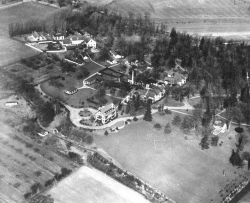Brigham Hall
| Brigham Hall | |
|---|---|
 | |
| Opened | 1855 |
| Closed | 1960 (As a psychiatric facility) |
| Current Status | Preserved |
| Building Style | Single Building |
| Location | Canandaigua, NY |
| Architecture Style | Gothic |
| Alternate Names |
|
History[edit]
After purchasing the 67 acres of woodland and open fertile fields with a partially finished mansion for $10,000 from the Eunice Clark family estate, Dr. Cook with the assistance of Robert Cook, Dr. John B. Chapin and Willard G. Wayne founded and opened Brigham Hall on Oct. 3, 1855. The complex — later expanded in 1860 to 100 acres — encompassed what is today almost all of the land bounded by South Pearl, Parrish, West and Bristol streets. The extensive grounds of Brigham Hall had a beautiful view of Canandaigua Lake and possessed many wildflowers, much wildlife and native trees. Dr. Cook often referred to the grounds as "the grove."
Dr. Cook named Brigham Hall after Dr. Amariah Brigham, the first superintendent of the State Asylum for the Insane in Utica. Dr. Brigham was at the time the most highly regarded doctor in the field of mental health and was held in world-wide esteem in the field of psychiatry. Before coming to Canandaigua, Dr. Cook had been an assistant physician under Dr. Brigham, who significantly influenced him in developing his humanistic approach to the treatment of the insane. Interestingly, Dr. Cook earned his M.D. degree from the Geneva Medical College in 1846, a former branch of today’s Hobart and William Smith Colleges.
When Brigham Hall opened in 1855, it was housed in the Clark family mansion, which was partially complete when the site was purchased. It was rapidly completed and was able to accommodate a dozen or so patients. Soon after opening, plans were made to make an expansion to the north side of the mansion. The two-story north wing opened in November 1856 with the first floor appropriated to the male patients and the second floor to the female patients. An additional expansion was made to the south side of the mansion (now the main administrative building) by 1860 that housed the female patients. The north-side expansion would now house the male patients. Additional structures were added to the Brigham Hall site between 1860 and 1876, including a large chapel, a recreation room, reading room, workshops, billiard hall, bowling alley and a large barn. The last major expansion on the site was the construction of the George Cook Building in 1936.
In addition to the need to expand the Brigham Hall facility, Dr. Cook and Dr. Chapin realized the importance of receiving a charter from the New York State Legislature incorporating the facility for the reception and care of the insane. Such a charter was prepared and passed by the Legislature in 1859. It is noteworthy that under this charter the use of the word "Hospital" was used for the first time by the State of New York to describe the medical character of an institution for the care and treatment of the insane. Previously, institutions of the insane were referred to as asylums or alm houses, which focused on their detention and incarceration. Brigham Hall Hospital was also one of only two private facilities in the state at that time. Public facilities at that time were quite limited, and most patients were held in county facilities.
From 1855 to 1961, Brigham Hall Hospital was administered by ten resident physicians in charge of the hospital. After Dr. George Cook died in 1876, Dr. Harvey Jewett was hired as an interim physician but did not live in Brigham Hall. In 1876, Dr. Dwight Burrell became resident physician until 1908 when Dr. Robert G. Cook [son of Dr. George Cook] was appointed. Dr. Robert G. Cook served until his retirement in 1929. Dr. Henry Burgess was hired in 1929 and served until his death in 1933. Dr. Robert Ross and later his wife Dr. Margaret Ross served the hospital until 1951. Dr. Francis Kelly assumed the position of resident physician until his resignation in 1956. Dr. Roy Van Allen was appointed in 1956 but died unexpectedly in 1957. The last resident physician was Dr. Howard Berg, who served until Brigham Hall was closed in 1961.
In addition to the efforts of these resident physicians, they were many more nurses, attendants, resident staff and members of the Board of Managers who oversaw the care and treatment of the patients of Brigham Hall. The range of services provided by the hospital included psychotherapy, treatment for alcoholism or drug addiction, physiotherapy, hydrotherapy, and electrotherapy as needed.
The common philosophy that was at the center of this hospital was the humanistic treatment of every patient. This treatment included providing settings for occupational therapy, permitting entertainment and artistic activities for the release of creative talents, offering individual attention to each patient’s needs, and furnishing an environment that promoted comfort and care. Brigham Hall provided private bedrooms; diversions including billiards, cards, games, books, music, and dancing; opportunities to perform light work about the grounds; and craft shops for both men and women. At any one time, Brigham Hall had between 65 and 80 patients.
In 1960, one of the hospital wings was converted to a nursing home as the number of mental patients applying to Brigham Hall was declining. The main reasons for this decline in private facilities like Brigham Hall were the changes in the treatment of mental patients with new drugs that allowed many people to remain in their homes, the increasing trend of housing mental patients in public facilities, and the rising costs of private care.
In 1961, Brigham Hall Hospital and its grounds were sold to Howard Samuels for $250,000. The nursing care facility known as the Grove Home continued to operate until 1979. However, the psychiatric care of Brigham Hall had come to an end. In 1967, Howard Samuels proposed converting the rest of the complex into a youth correctional institution, which was met with a great deal of community opposition. John and Noreen Black, who had partnered with Samuels in operating the Grove Home, ultimately bought it. They closed the Grove Home, mainly due to the rising costs of nursing homes that were the result of increased state regulations. In 1979, the Blacks converted the main buildings into the Brigham Hall Condominiums.
Today, the grounds of the old Brigham Hall are home to the condominiums and the Heritage House apartments as well as several single family homes. Brigham Hall is gone but it is not forgotten. [1]




